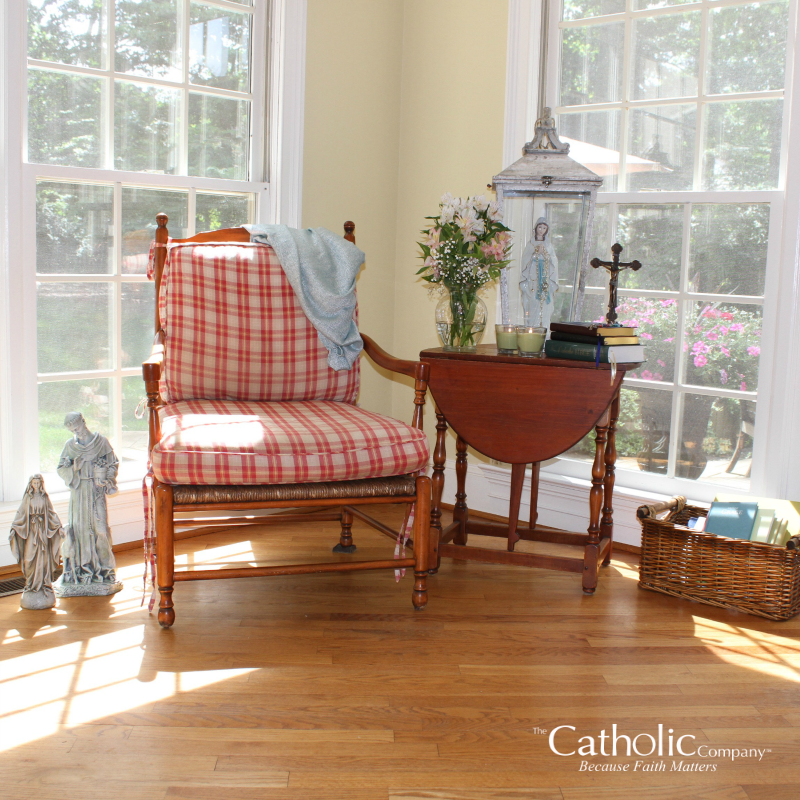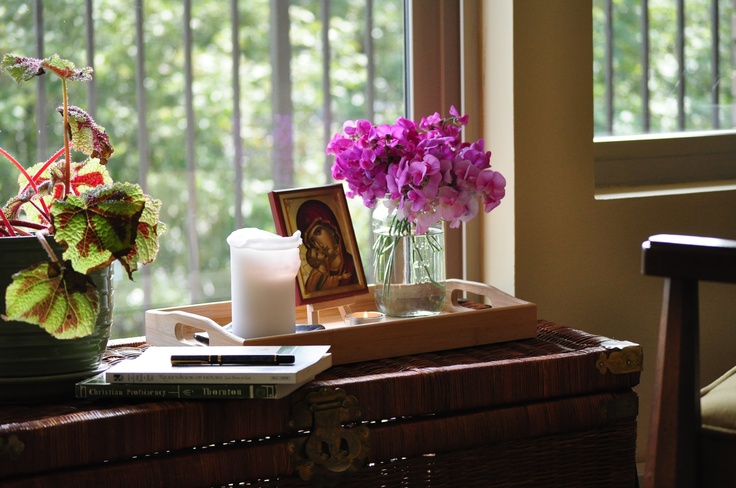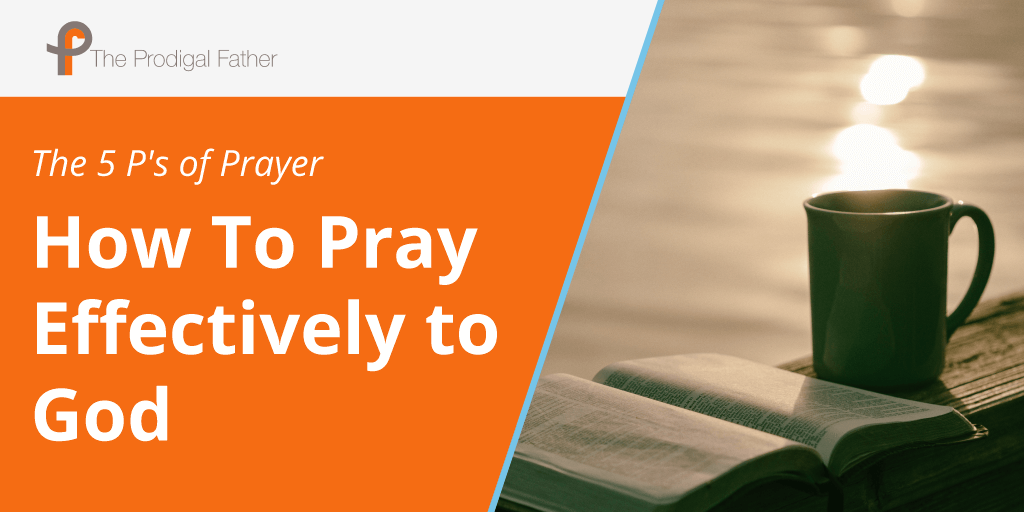
Introduction
The following is a wonderful exercise that you can use every day. It was given to me by a very wonderful Jesuit priest named Fr. Bob Welsh (listen to his Praying with Priests interview here). He led me on my first ever eight-day silent retreat, and it changed my life and the way I pray! These tips are practical ways of entering into prayer.
So... What Are The 5 P's of Prayer?
No matter how experienced you are with prayer, it helps to have some structure. The 5 P's of Prayer provides an excellent routine. These steps can be especially helpful to you if you are new to prayer.
1. Preparation
It is helpful to spend some time getting ready to pray. If we know what we are going to pray with when we go to pray, then we will be less likely to waste time during prayer trying to figure it.
Preparing for prayer could be as simple as just being aware of how we want to pray. It may be thinking about what you want to talk to God about. Perhaps there is a scripture passage that you would like to focus on while you pray.
You may think about where you want to pray and if there are any sacramentals that you would like to have with you. Will you need your bible, a journal, a pen, a spiritual book, The Rosary, or some other sacramentals?
If you know what you are going to pray with it helps to look forward to the sacred time you have. You can already start thinking about it ahead of time, anticipating your time with God, and fostering a sense of hopeful expectation.
The time that we spend in preparation can increase our desire to encounter God when we pray. For example, if you are going to pray the Rosary in the evening, you can think about and meditate upon the mysteries while you are at work.
If you are going to pray with the daily readings in the morning, it will help to look at them at night and ponder them while you sleep.
It is also important to set time aside every day for prayer. The saints and mystics often talk of a Holy Hour. The Catechism teaches:
"The choice of the time and duration of the prayer arises from a determined will, revealing the secrets of the heart. One does not undertake contemplative prayer only when one has the time: one makes time for the Lord, with the firm determination not to give up, no matter what trials and dryness one may encounter." (CCC 2710)
Setting a time and duration for prayer is an important part of preparation. Start with as little as five or ten minutes and you will love it so that The Holy Spirit may even invite you to even more quality time!
Prayer is a very personal meeting with God your Father. Just like we would prepare ahead of time if we were going to meet someone we greatly esteem for an interview, or go on a dinner date with the person that we love, or grab coffee with our best friend, even preparing can be a wonderful time for us leading up to our actual prayer time with God.
2. Place
We need to find a sacred place for ourselves that is conducive to praying. The reason we build churches is so that we have a sacred place where we can go to pray. Every Catholic Church has the Blessed Sacrament present. The Church is explicitly designed to be a place of prayer most importantly when we gather together to celebrate the Eucharist.
It is also a place for us to pray privately. The placement must allow for a focus on the tabernacle for those periods of quiet prayer outside the celebration of the Eucharist.
The tabernacle may be in the sanctuary near the main altar, or your church may have an Adoration Chapel where you can pray before the Blessed Sacrament. Sometimes churches will even have Eucharistic Adoration where you can pray before the exposed Eucharist.
It may not always be possible to pray in your church. Sometimes churches are not open, quiet, heated, or comfortable for you to pray in. It is also essential that you have a place to pray in your own home. Do you have a place in your home that is dedicated to prayer? If not, now is a great time to create one.
Your prayer place could be a spare room that you can convert into a chapel. It may also be a place in your home where you feel very comfortable spending time in solitude. It could be as simple as a prayer corner or a prayer chair.
Traditionally many Catholics have had a "Home Altar" which is a table, shelf or stand with Sacramentals (For example for example a candle, statue, holy image, or crucifix). These "smells and bells" really do help us to focus our attention on God.
When you go to this place, you know it is time to pray. Half the battle is just getting there!
3. Posture
We believe that our bodies and souls are one. What this means for prayer is that what we do with our bodies impacts the way that we pray and expresses what we believe. Traditionally, there are four postures for praying: standing, sitting, kneeling or prostrating (laying our bodies down).
When we stand, there is a certain attentiveness and urgency. With sitting, we are prepared to receive God's Word. Kneeling expresses our humility and honor for God. Finally, there is prostrating, which is lying face down and surrendering whole life to God.
These postures are all beautiful ways of praying. There may be different times that you pray in different positions. Sometimes it helps just to be aware of how we are presenting ourselves to God. Try different postures and see what feels most reverent to you.
4. Passage
The passage is the source of whatever it is that you are praying with (a passage from the Gospels, your favorite verse of scripture, a Holy Icon, or any other sacramental that you feel God inspiring you to focus your attention on.
5. Presence
Finally, after preparing, going to your place, settling into a posture, focusing on a passage, now allow yourself to realize you are in the presence of God. Make the sign of the cross. Let God, The Father, hold you and comfort you.
Allow Jesus to be with you as your best friend, your Good Shepherd, your most intimate companion. Invite the Holy Spirit to help you enter into the presence of God.
Do you want to learn how to pray Lectio Divina yourself?
It's a great prayer that uses the foundations you're learning here. Check it out!
Place: Why Is It So Important?
90% of prayer is just being "there" and in that "place." If you don't have a place to pray, it won't happen. If you do have a place to pray and you at least physically place yourself there, the prayer will happen!
Every home should have a sacred space; a prayer room, a prayer corner, or, at least, a "prayer chair." If you do have a place like this, then the first thing you need to do is get it ready. If you don't have a place like this yet, treat yourself. You are worth it.
As for me and my household, we will serve the LORD. (Joshua 24:15)
A very concrete way for this to happen is to have a place in your home that you dedicate to God. When you go to this sacred place, you will be surrounded by reminders that you are in the presence of God. When you are there not only will it help you to be undisturbed but others in your house will also grow to know not to disturb you when you are there.
It's important to understand this ourselves as well as express it to others. Let it be a time for you to focus solely on God. Turn off your phone, silence your heart. St. John XXIII had a plaque made (as do I) that he had hung above the door to his prayer room: "Pray, Read, Withdraw, Be Silent, Be at Peace."
Check out some ideas and layouts:
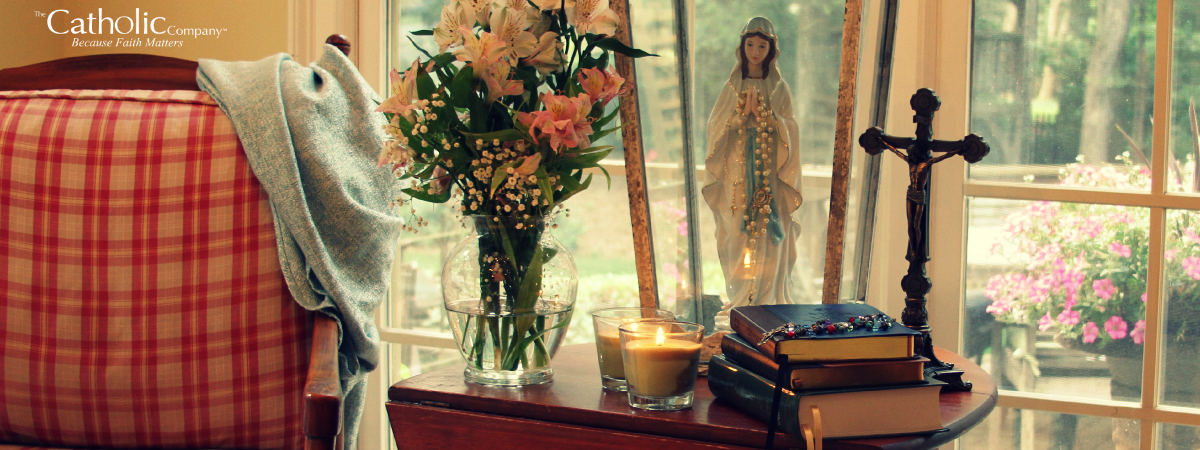
Fr. Michael's Prayer Corner
What could I put in my prayer space?
Consider ordering sacramentals. What are sacramentals? They are deeply-rooted in or imitate the Church's official rituals and are sacred signs that remind us Catholics about the sacraments. These can include physical items like rosary beads, prayer medals, statues, etc. They also can be non-physical items like music, gestures, devotional prayers, and more. If you're looking to create or add to your prayer space, check out some of my suggestions!
Crucifix
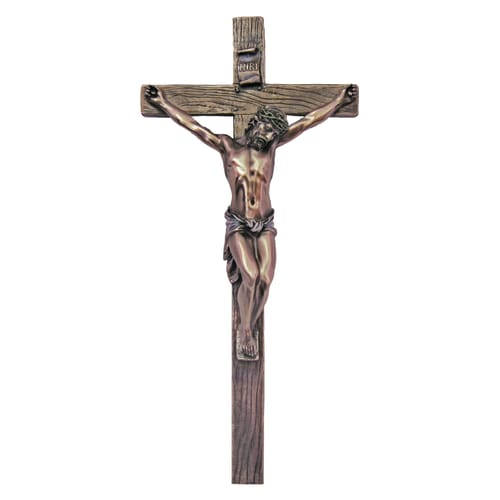
Icon
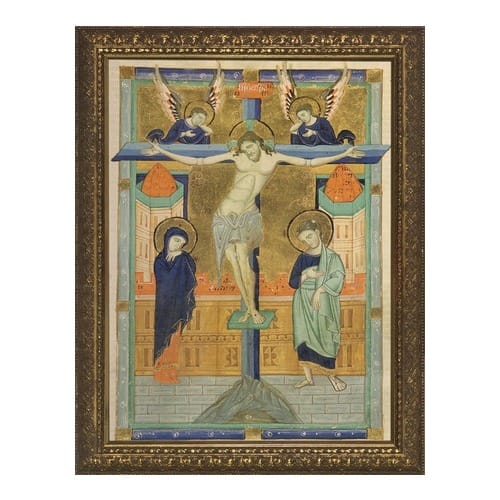
Statue
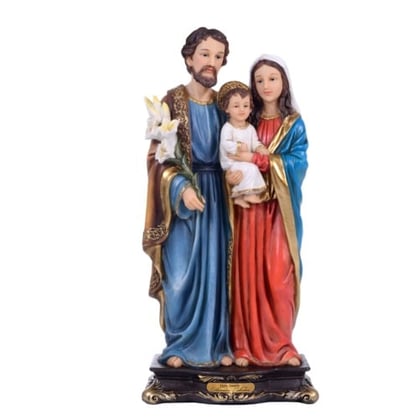
Rosary
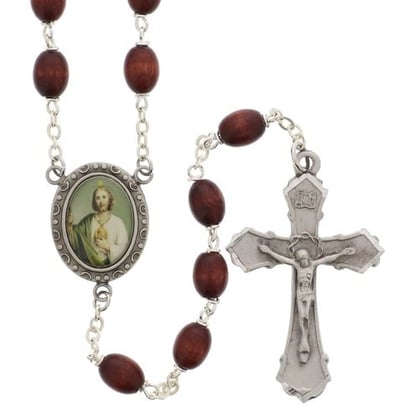
Bible
...and more such as:
- Holy Water Font*
- Holy Painting or picture*
- Spiritual Books*
- Candles
- Keepsakes from your loved ones
- Holy Water
- Prayer Medals
You may have a religious goods store nearby. Go there! They will have everything you need to set up your space.
...Why Sacramentals you ask?
"Holy Mother Church has, moreover, instituted sacramentals. These are sacred signs which bear resemblance to the sacraments. They signify effects, particularly of a spiritual nature, which are obtained through the intercession of the Church. By them, men are disposed to receive the chief effect of the sacraments, and various occasions in life are rendered holy" (CCC, 1667).
You don't need to go overboard, and these are just to give you ideas. You surely have "religious" items in our home already--use those and arrange them in a way where you can sit comfortably in a chair and see them.
Keep in mind these are only suggestions, but do "treat" yourself! You are worth it, and so is God!
Get Comfortable
Now that you have your "prayer room" or "sacred space" set up, it is beneficial to get comfortable in it. You are going to be spending some great quality time there, and you should feel comfort and a sense of warmth whenever you enter. Consider some ritual to make it feel sacred. Just like the church uses incense, candles, organ music, and stained glass windows, it is also good for us to transition from the ordinary to the sacred.
Mother Theresa insisted that all of her nuns remove their shoes or sandals before entering the chapel to pray.
I have prayed in a number of their chapels throughout the world, and I have to say this is a very profound experience and sets you up to pray. God said:
Do not come near! Remove your sandals from your feet, for the place where you stand is holy ground" (Exodus 3:5).
Another great sacramental is a Holy Water font. Consider placing this right by the entryway to your "sacred space" so whenever you enter it, you can make the Sign of the Cross. Holy Water is a very powerful sacramental that not only draws you close to God but also protects you from the devil.
You may want to light a candle, play some sacred music, put on some noise canceling headphones, or have a space heater. Whatever you can do to help make it a beautiful place of encounter for you and God.
The Different Types of Prayer Postures
Now that you are in your room try different prayer postures. Traditionally, the Church has four postures: standing, sitting, kneeling, and prostrating.
You experience most of these at Sunday Mass! Think about how many times you change postures during Mass. Each posture is intentional and has some meaning and purpose.
Here are some examples with quotes from scripture.
Standing
"At that time the LORD set apart the tribe of Levi to carry the ark of the covenant of the LORD, to stand before the LORD to minister to him and to bless in his name, as they have done to this day" (Deuteronomy 10:8).
"Be vigilant at all times and pray that you have the strength to escape the tribulations that are imminent and to stand before the Son of Man" (Luke 21:36).
Kneeling

"that at the name of Jesus every knee should bend, of those in heaven and on Earth, and under the Earth" (Phil. 2:10).
Sitting
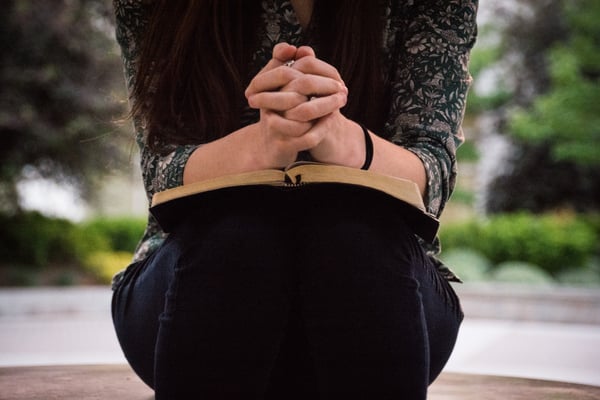
"Moving on from there Jesus walked by the Sea of Galilee, went up on the mountain, and sat down there" (Matthew 15:29).
"The Lord appeared to Abraham by the oak of Mamre, as he in the entrance of his tent, while the day was growing hot" (Genesis 18:1).
Prostrating
"But Moses and Aaron went away from the assembly to the entrance of the tent of meeting, where they fell prostrate... Then the glory of the LORD appeared to them" (Numbers 20:6).
"Then, he brought me by way of the North gate to the facade of the temple. I looked--and then the glory of the LORD filled the LORD's house! I fell on my face. The LORD said to me: Son of man pay close attention, look carefully, and listen intently to everything I tell you" (Ezekiel 44: 4-5).
"And one of them realizing he had been healed, returned, glorifying God in a loud voice; and he fell at the feet of Jesus and thanked him" (Luke 17:15-16).
Conclusion
Practice these different prayer postures and see how they affect you. You may experiment all you want before prayer, but try to remain in one prayer posture for your entire period unless God moves you otherwise.
Spend two minutes (as best as you can without hurting yourself) today in each of the postures for a total of 10 minutes. During that time, meditate on any Scripture passage that you choose. Let yourself feel and experience what it is like to pray in each posture.
Reflect on your experience now. What was it like? Which posture felt most comfortable? Did you feel closer to God with any of the postures? Which posture helped you pray? Did you sense that you were in God's presence? Is there a posture you would like to try next time you pray?
When you're ready, take some time to journal your thoughts.
Did you enjoy participating in this prayer exercise? Do want to experience the complete Pray 40 Days program to build the personal relationship with God you've always wanted? Sign up here or purchase the book.
*Disclaimer: Sometimes my blog posts contain affiliate links for products we love and want to recommend to our subscribers. The Prodigal Father Productions earns a small commission on these links, at no cost to you. We will always be sure to distinguish these affiliate links with an asterisk for your transparency.

